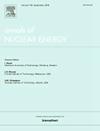A robust diagnosis method specifically for similar faults in nuclear power plant multi-systems based on data segmentation and stacked convolutional autoencoders
IF 1.9
3区 工程技术
Q1 NUCLEAR SCIENCE & TECHNOLOGY
引用次数: 0
Abstract
Nuclear power plants consist of multiple subsystems characterized by nonlinear correlations, numerous monitoring parameters, and faults with similar characteristics. These similar faults often exhibit closely distributed data points, resulting in unclear classification boundaries and reduced diagnostic accuracy for fault detection algorithms. A single deep learning model cannot establish a diagnostic model that is broad in scope, highly accurate, and robust. This paper proposes a robust, multi-system similar fault diagnosis model for nuclear power plants, combining K-Means and Stacked Convolutional Autoencoders (KSCAE). First, K-Means data segmentation model partitions complex multi-system fault data into several similar data clusters. Then, specialized diagnostic models are developed for each cluster using powerful stacked convolutional autoencoders to focus on learning and classifying similar faults. Testing across three nuclear power plant fault diagnosis scenarios based on data from the Fuqing nuclear power plant simulator demonstrates that KSCAE outperforms single deep learning models in diagnostic accuracy, particularly when fault severity differs between training and testing sets. The results show that the KSCAE algorithm achieves a maximum accuracy of 99.31% and a minimum accuracy of 79.11% under severe noise and data distribution differences. Compared to the baseline algorithms, KSCAE achieves an average accuracy improvement of up to approximately 20% across multiple tests, particularly in Scenario 2. This study demonstrates the effectiveness and robustness of the proposed model for diagnosing similar faults, providing a reliable approach for multi-system fault diagnosis in nuclear power plants.
求助全文
约1分钟内获得全文
求助全文
来源期刊

Annals of Nuclear Energy
工程技术-核科学技术
CiteScore
4.30
自引率
21.10%
发文量
632
审稿时长
7.3 months
期刊介绍:
Annals of Nuclear Energy provides an international medium for the communication of original research, ideas and developments in all areas of the field of nuclear energy science and technology. Its scope embraces nuclear fuel reserves, fuel cycles and cost, materials, processing, system and component technology (fission only), design and optimization, direct conversion of nuclear energy sources, environmental control, reactor physics, heat transfer and fluid dynamics, structural analysis, fuel management, future developments, nuclear fuel and safety, nuclear aerosol, neutron physics, computer technology (both software and hardware), risk assessment, radioactive waste disposal and reactor thermal hydraulics. Papers submitted to Annals need to demonstrate a clear link to nuclear power generation/nuclear engineering. Papers which deal with pure nuclear physics, pure health physics, imaging, or attenuation and shielding properties of concretes and various geological materials are not within the scope of the journal. Also, papers that deal with policy or economics are not within the scope of the journal.
 求助内容:
求助内容: 应助结果提醒方式:
应助结果提醒方式:


